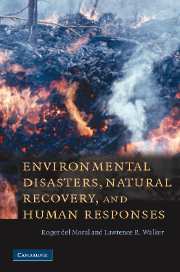Book contents
- Frontmatter
- Contents
- Preface and acknowledgements
- 1 Introduction: a crescendo of destruction
- 2 Natural disturbances: synergistic interactions with humans
- 3 Infertile and unstable habitats
- 4 Infertile and stable habitats
- 5 Fertile and unstable habitats
- 6 Fertile and stable habitats
- 7 The lessons learned
- Glossary
- Illustration credits
- Index
- Plate section
- References
3 - Infertile and unstable habitats
Published online by Cambridge University Press: 11 September 2009
- Frontmatter
- Contents
- Preface and acknowledgements
- 1 Introduction: a crescendo of destruction
- 2 Natural disturbances: synergistic interactions with humans
- 3 Infertile and unstable habitats
- 4 Infertile and stable habitats
- 5 Fertile and unstable habitats
- 6 Fertile and stable habitats
- 7 The lessons learned
- Glossary
- Illustration credits
- Index
- Plate section
- References
Summary
INTRODUCTION
Some of the most dramatic landscapes on earth scarcely support life because they are infertile and unstable. Infertility limits growth and instability limits establishment. These neglected, barren habitats of our world once escaped human impact because of their isolation and because productive habitats were more profitable. Today, humans are creating similarly impoverished habitats, but unlike natural ones, human-created barrens are close to human habitats and less productive. Due to the continuing global loss of usable habitat, these unproductive environments could be restored for human use.
Volcanoes, moving sands and glaciers all form infertile and unstable habitats. In the aftermath of violent cataclysms, volcanoes can create unstable surfaces such as lahars and scoria. The slow advance of sterile sand dunes across the landscape has both beneficial and catastrophic aspects. While coastal dunes protect the shores, interior dunes are expanding at alarming rates to threaten many communities and ruin pastoral lands. However, many interior dunes also support rare and complex ecosystems. The grinding, global retreat of glacial ice reveals jumbled barrens. The biota colonizes these inhospitable sites only with difficulty and persistence. Plants and animals eventually colonize the empty habitats formed by volcanoes, dunes and melting glaciers and when they do their success offers lessons for restoration of similar infertile and unstable habitats. In this chapter, we explore the constraints to establishment on these severely altered ecosystems and suggest that even they have value for sustaining economies and easing pressure on other habitats.
- Type
- Chapter
- Information
- Publisher: Cambridge University PressPrint publication year: 2007



